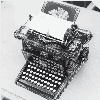Keyboards: Just the Facts
Everything you ever wanted to know about keyboards.
We may earn revenue from the products available on this page and participate in affiliate programs. Learn more ›

by Herkimer County Historical Society
Some typists hunt and peck, but most serious keyboard-bangers use QWERTY.
The QWERTY (named for the key placement of the upper left row) key arrangement has spawned millions of touch typists-and enduring controversies concerning its value as well. Its inventor, Christopher L. Sholes, began its development in 1867; the layout is still dominant today. It was used on the Sholes & Glidden Type-Writer, manufactured by E. Remington & Sons (better known for their firearms) beginning in 1874.
Sholes is often said to have deliberately placed the keys to slow down typists so that the rods holding the keys would not clash and stick. Other accounts report that, in fact, he pored over studies of letter frequencies and common combinations to avoid such clashes.
August Dvorak posed a major threat to QWERTY in 1932 with a keyboard that placed vowels and the five most commonly used consonants on the home row. Using the Dvorak keyboard, a typist can type about 400 of the most common words without leaving the home row, compared with 100 on QWERTY. Despite this and other advantages, the Dvorak never overcame QWERTY’s established base of users.
Want to give Dvorak a go? Most computer keyboards can be reset to Dvorak and other configurations. See njnj.essortment.com/keyboard_histo_ rdqo.htm. Don’t forget to re-label the keys.
Mark Twain was among the first typewriter users; although he didn’t type it himself, he is credited with being the first to submit a novel to a publisher in typed form. That was Life on the Mississippi in 1883.
Do your fingers sometimes tingle? Are your wrists occasionally stiff? You may have carpal tunnel syndrome. Ergonomic keyboards, such as Microsoft’s Natural, introduced in 1994, were developed to address such repetitive stress injuries.
The most popular type of ergonomic design is the split-key. This type of board aims to straighten the wrists by increasing the distance between the right and left sides of the keyboard or by rotating the two halves of the keyboard so that both are aligned with the forearm.
Hate pecking away at a PDA keypad? The 9-inch by 3-inch water-resistant roll-up Flexis FX100, with a QWERTY layout, enables you to touch-type on a handheld computer. It’s garnered praise for the tactile feedback of its “keys.”
Avoid the impact of keystroking altogether, suggests Fingerworks of Newark, Delaware. Its Touchstream keyless keyboards use a sensor array that recognizes fingers as they move above it.
The Fastap keypad from Digit Wireless of Cambridge, Massachusetts, is a replacement for the 50-year-old telephone keypad. The pad is about one-third the size of a business card. It’s a bit like having two keypads in the same space: The letters are raised and the numbers are lowered.
The newest computer keyboards offer one-touch access to e-mail, the Internet, and multimedia.
–Compiled by Bob Sillery